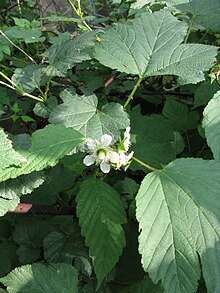| Rubus crataegifolius | |
|---|---|

| |
| May 2009, Japan | |
| Scientific classification | |
| Kingdom: | Plantae |
| Clade: | Tracheophytes |
| Clade: | Angiosperms |
| Clade: | Eudicots |
| Clade: | Rosids |
| Order: | Rosales |
| Family: | Rosaceae |
| Genus: | Rubus |
| Subgenus: | R. subg. Idaeobatus |
| Species: | R. crataegifolius
|
| Binomial name | |
| Rubus crataegifolius | |
Rubus crataegifolius, also called Korean raspberry,[1] is a species of raspberry native to East Asia.[2]

It is a shrub growing to 1–2 m (rarely 3 m) tall. The leaves are 5–12 cm long and 5–8 cm broad, palmately lobed with three or five lobes, and a serrated margin. The flowers are 1–1.5 cm diameter, with five white petals. The fruit is an aggregate fruit 1 cm diameter, made up of numerous drupelets. The species grows on forest margins and mountain slopes, in areas with moist and well-drained soil.
Its fruit is used for food and is sometimes cultivated; the cultivar 'Jingu Jengal' has been selected for its large fruit.[3] Root extracts have been found to contain substances with anti-inflammatory effects in mice.[4]
Notes[edit]
- ^ English Names for Korean Native Plants (PDF). Pocheon: Korea National Arboretum. 2015. p. 612. ISBN 978-89-97450-98-5. Archived from the original (PDF) on 25 May 2017. Retrieved 22 December 2016 – via Korea Forest Service.
- ^ "Rubus crataegifolius Korean raspberry PFAF Plant Database". www.pfaf.org.
- ^ Plants for a Future :Rubus crataegifolius
- ^ Cao Y, Wang Y, Jin H, Wang A, Liu M, Li X (1996). "Anti-inflammatory effects of alcoholic extract of roots of Rubus crataegifolius Bge. (PubMed abstract)". Zhongguo Zhong Yao Za Zhi. 21 (11): 687–8. PMID 9812702.
External links[edit]
 Data related to Rubus crataegifolius at Wikispecies
Data related to Rubus crataegifolius at Wikispecies Media related to Rubus crataegifolius at Wikimedia Commons
Media related to Rubus crataegifolius at Wikimedia Commons- "Rubus crataegifolius". Plants for a Future.